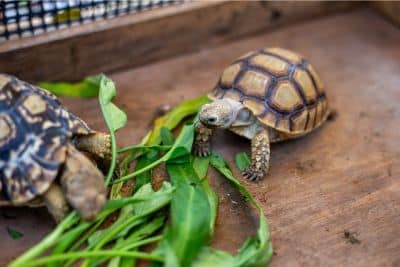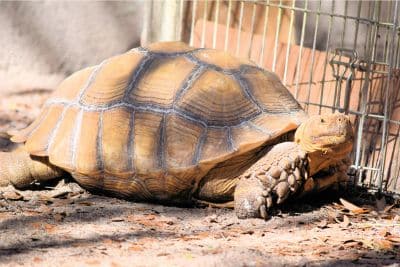Even though they are terrestrial animals who primarily live on dry land, tortoises – like all other animals – require water to survive. This includes rainforest-dwelling red-footed tortoises (Chelonoidis carbonarius), desert-dwelling sulcatas (Centrochelys sulcata), and every species in between.
From the keeper’s perspective, this means that it is necessary to provide all tortoises with a suitable water dish. But that is not as simple as providing a water bowl to a dog or cat, thanks to the unique anatomy of tortoises.
But don’t worry – I’ll explain everything you need to know about providing your tortoise with a water dish and cover some of the other aspects of tortoise hydration below.
Considerations
There are a few key things you will need to keep in mind when selecting a water dish for your tortoise. Some of the most important considerations include:
- The water dish must not be deep enough to represent a safety hazard. Tortoises are not strong swimmers, and their shells are bulky, which means they are not especially agile animals. This unfortunately means that they are at risk of drowning in their water dish if they fall in (especially if they topple over and land upside down). Accordingly, you will always want to stick with relatively shallow dishes at all times.
- Wide dishes are preferable to narrow dishes. Because of the unique anatomy of tortoises, narrow water dishes can be tricky for them to access and use. Instead, try to select a wide water dish, which your tortoise can actually crawl inside. This will provide your pet with the best possible access to the water.
- The water dish must be easy to clean. It is vital that you empty, clean, and refill your tortoise’s water dish regularly (every one to two days). Additionally, you’ll want to sterilize it periodically by soaking it in a 5% bleach solution for several hours and then rinsing it thoroughly. So, opt for durable, smooth-sided water dishes which don’t feature many hard-to-reach nooks or crannies.
- Ideally, the water dish should be somewhat heavy. Because tortoises can be a bit clumsy, I recommend selecting a water dish that won’t topple over very easily. This means opting for water dishes that are made from ceramic or some other dense material. The extra weight will help keep the dish upright and prevent water from spilling inside the habitat.
- While you don’t want to compromise on quality, affordability is helpful. It’s always worth saving money on tortoise supplies when you can, if for no other reason than you can spend those saved dollars on other tortoise supplies.
It is important to note that many of the factors discussed above are at odds with each other. For example, lightweight water dishes are more affordable and easier to clean, but they are also more likely to tip over. So, as with so many other aspects of tortoise husbandry, you’ll have to make trade-offs when selecting the ideal water dish for you and your tortoise.
Options
There is no single water dish that works for all tortoises, keepers, or situations. However, the following are a few of the best options:
Safe, easy-to-clean, and affordable, these water bowls are the best option for most keepers in my opinion. They are also very affordable, thanks to their all-plastic construction.
Bear in mind however, that the round shape presents both benefits and drawbacks. On the plus side, round dishes work well for tortoises, but on the other hand, round dishes are not very space-efficient inside your pet’s habitat.
2. Fun Elements Shallow Dog Bowls
Though designed for dogs, these water dishes will work well for tortoises too. They are quite shallow (measuring less than 2-inches deep), which makes them safe, yet their 10.5-inch diameter will allow most tortoises to access water easily.
The heaviest option we recommend here, these water dishes are the least likely to tip over, though they will be slightly more difficult to empty, clean, and replace, given their additional weight.
3. WOLEDOE Reptile Food and Water Dish
These shatterproof dishes are very lightweight, and they are both shallow and wide, which makes them safe while still being easy for tortoises to access.
They will, however, need to be refilled frequently, thanks to their super wide-and-shallow design, as this design facilitates the rapid evaporation of water.
4. Zoo Med Reptile Rock Food Dish
Highly intricate, decorative water dishes are usually not the best option, as they’re harder to keep clean. In fact, the myriad crevices will often harbor bacteria such as Salmonella and necessitate very frequent cleanings.
However, if you simply must have a decorative water dish, this is probably the best option around, and it is shallow enough to be safe for most tortoises.
5. The HC Companies 21 Inch Round Prima Plastic Plant Saucer
There aren’t many commercially manufactured water dishes available for large tortoises, but these 21-inch plastic plant saucers will work.
They’re not very heavy, which means they’ll be easy to clean, but that does mean they’re more likely to tip over. They are also surprisingly affordable, given their size.
Additional Tortoise Hydration Measures
In addition to your tortoise’s water dish, I find it’s wise to employ two other practices, which will help ensure your tortoise remains properly hydrated. This is especially important for young tortoises and those species who normally live in rainforests. In fact, poor hydration in young tortoises is likely the reason many tortoises develop “pyramided” shells.
So, in addition to always keeping a dish full of clean water available, I recommend the following:
- Employ a regular soaking regimen. It’s a good idea to allow your tortoise to soak in 1 to 2 inches of room temperature water one to three times per week (some keepers even do so on a daily basis for very young individuals).
The water should always be shallow enough that the tortoise can easily raise his head above the surface – do not make him struggle to breathe in any way. These soaks should last for about 15 to 60 minutes each.
Be sure to monitor your tortoise closely during this time so that you can take action if he shows signs of distress or flips upside down.
- Maintain a high humidity level in one of the hide boxes. In the wild, most tortoise burrows and retreats have higher ambient humidity levels than the surrounding air. This is part of the reason that tortoises often retreat to burrows during exceptionally hot or dry weather. So, mimic this in captivity by maintaining a high humidity level in one of your pet’s hide boxes.
You can accomplish this by simply dampening the substrate beneath the hide. Just be sure that your tortoise also has access to a dry hide, which he can use as he sees fit.
Some keepers also like to mist their tortoise’s food with a bit of water before meals, to help provide even more water. The diet of most tortoises already contains quite a bit of water (in fact, this is how tortoises obtain a lot of the water they need in the wild), but it doesn’t hurt to provide a little more.
If you’ve enjoyed this article and are keen to learn more about tortoise necessities, here’s a link to Essential Tortoise Supplies.
Citations
- Tortoise Trust – Tortoises: Do They Need to Drink?
- The Tortoise Table – Routine Care
- Arizona Exotic Animal Hospital – Pyramiding in Tortoises


